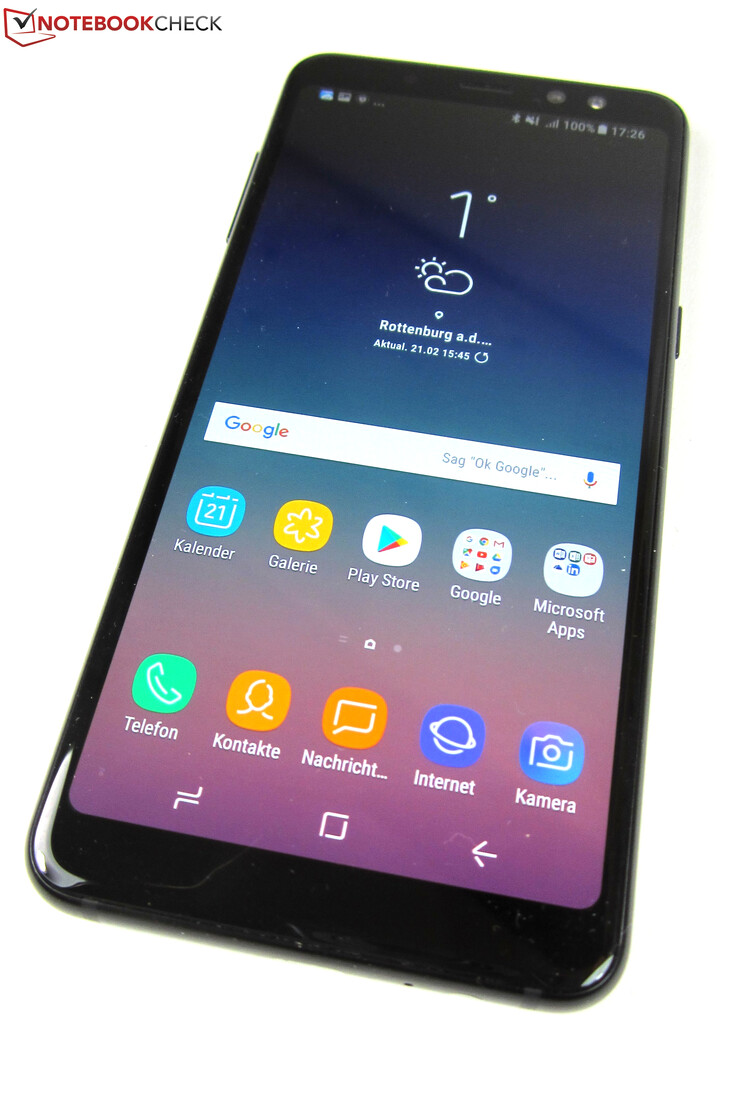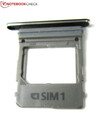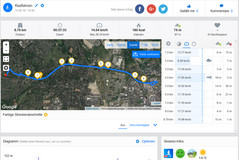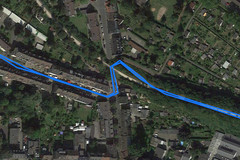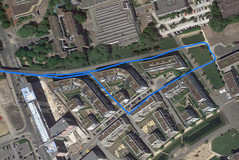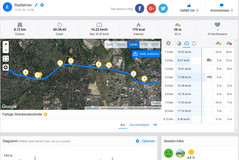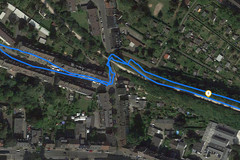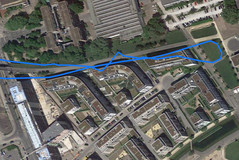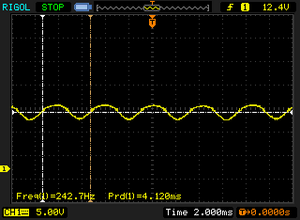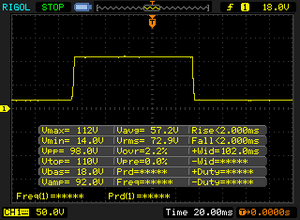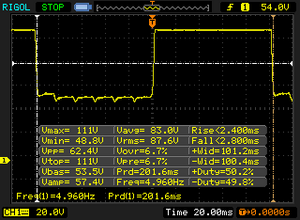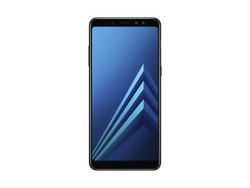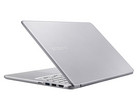Recensione breve dello Smartphone Samsung Galaxy A8 2018
I nostri Top 10
» Top 10 Portatili Multimedia
» Top 10 Portatili Gaming
» Top 10 Portatili Gaming Leggeri
» Top 10 Portatili da Ufficio e Business economici
» Top 10 Portatili Premium da Ufficio/Business
» Top 10 Portatili sotto i 300 Euro
» Top 10 Portatili sotto i 500 Euro
» Top 10 dei Portatili Workstation
» Top 10 Subnotebooks
» Top 10 Ultrabooks
» Top 10 Convertibili
» Top 10 Tablets
» Top 10 Tablets Windows
» Top 10 Smartphones
Size comparison
| Networking | |
| iperf3 transmit AX12 | |
| OnePlus 5T | |
| Sony Xperia XZ1 | |
| Asus ZenFone 4 ZE554KL | |
| Samsung Galaxy A8 2018 | |
| BQ Aquaris X Pro | |
| Honor 9 | |
| iperf3 receive AX12 | |
| Sony Xperia XZ1 | |
| OnePlus 5T | |
| Asus ZenFone 4 ZE554KL | |
| Honor 9 | |
| Samsung Galaxy A8 2018 | |
| BQ Aquaris X Pro | |
| |||||||||||||||||||||||||
Distribuzione della luminosità: 96 %
Al centro con la batteria: 541 cd/m²
Contrasto: ∞:1 (Nero: 0 cd/m²)
ΔE ColorChecker Calman: 5.8 | ∀{0.5-29.43 Ø4.78}
ΔE Greyscale Calman: 2.7 | ∀{0.09-98 Ø5}
Gamma: 2.07
CCT: 6570 K
| Samsung Galaxy A8 2018 Super AMOLED, 2220x1080, 5.6" | Asus ZenFone 4 ZE554KL IPS, 1920x1080, 5.5" | BQ Aquaris X Pro IPS, 1920x1080, 5.2" | Honor 9 IPS/LTPS, 1920x1080, 5.2" | OnePlus 5T AMOLED, 2160x1080, 6" | Sony Xperia XZ1 IPS, 1920x1080, 5.2" | |
|---|---|---|---|---|---|---|
| Screen | -10% | -69% | 1% | 5% | 2% | |
| Brightness middle (cd/m²) | 541 | 656 21% | 458 -15% | 550 2% | 425 -21% | 620 15% |
| Brightness (cd/m²) | 538 | 634 18% | 473 -12% | 535 -1% | 423 -21% | 610 13% |
| Brightness Distribution (%) | 96 | 93 -3% | 88 -8% | 92 -4% | 92 -4% | 93 -3% |
| Black Level * (cd/m²) | 0.4 | 0.51 | 0.42 | 0.79 | ||
| Colorchecker dE 2000 * | 5.8 | 5.3 9% | 7.1 -22% | 3.3 43% | 2.1 64% | 4.2 28% |
| Greyscale dE 2000 * | 2.7 | 5.2 -93% | 10.5 -289% | 3.6 -33% | 2.5 7% | 3.9 -44% |
| Gamma | 2.07 106% | 2.22 99% | 2.28 96% | 2.38 92% | 2.32 95% | 2.02 109% |
| CCT | 6570 99% | 7905 82% | 8951 73% | 7226 90% | 6455 101% | 7086 92% |
| Contrast (:1) | 1640 | 898 | 1310 | 785 | ||
| Colorchecker dE 2000 max. * | 7.8 | 14.5 | 4.5 | 3.4 | 5.8 |
* ... Meglio usare valori piccoli
Sfarfallio dello schermo / PWM (Pulse-Width Modulation)
| flickering dello schermo / PWM rilevato | 242.7 Hz | ||
Il display sfarfalla a 242.7 Hz (Probabilmente a causa dell'uso di PWM) . La frequenza di 242.7 Hz è relativamente bassa, quindi gli utenti sensibili potrebbero notare il flickering ed accusare stanchezza agli occhi a questo livello di luminosità e a livelli inferiori. In confronto: 53 % di tutti i dispositivi testati non utilizza PWM per ridurre la luminosita' del display. Se è rilevato PWM, una media di 8111 (minimo: 5 - massimo: 343500) Hz è stata rilevata. | |||
Tempi di risposta del Display
| ↔ Tempi di risposta dal Nero al Bianco | ||
|---|---|---|
| 4 ms ... aumenta ↗ e diminuisce ↘ combinato | ↗ 2 ms Incremento | |
| ↘ 2 ms Calo | ||
| Lo schermo ha mostrato valori di risposta molto veloci nei nostri tests ed è molto adatto per i gaming veloce. In confronto, tutti i dispositivi di test variano da 0.1 (minimo) a 240 (massimo) ms. » 15 % di tutti i dispositivi è migliore. Questo significa che i tempi di risposta rilevati sono migliori rispettto alla media di tutti i dispositivi testati (20.2 ms). | ||
| ↔ Tempo di risposta dal 50% Grigio all'80% Grigio | ||
| 5.2 ms ... aumenta ↗ e diminuisce ↘ combinato | ↗ 2.4 ms Incremento | |
| ↘ 2.8 ms Calo | ||
| Lo schermo ha mostrato valori di risposta molto veloci nei nostri tests ed è molto adatto per i gaming veloce. In confronto, tutti i dispositivi di test variano da 0.165 (minimo) a 636 (massimo) ms. » 16 % di tutti i dispositivi è migliore. Questo significa che i tempi di risposta rilevati sono migliori rispettto alla media di tutti i dispositivi testati (31.6 ms). | ||
| Lightmark - 1920x1080 1080p (ordina per valore) | |
| Samsung Galaxy A8 2018 | |
| Asus ZenFone 4 ZE554KL | |
| Oukitel K10 | |
| Ulefone Power 3 | |
| Media Samsung Exynos 7885 (n=1) | |
| Basemark ES 3.1 / Metal - offscreen Overall Score (ordina per valore) | |
| Samsung Galaxy A8 2018 | |
| Asus ZenFone 4 ZE554KL | |
| Oukitel K10 | |
| Ulefone Power 3 | |
| Media Samsung Exynos 7885 (n=1) | |
| Media della classe Smartphone (205 - 7731, n=36, ultimi 2 anni) | |
| JetStream 1.1 - Total Score | |
| OnePlus 5T (Chrome 63) | |
| Sony Xperia XZ1 (Chrome 61) | |
| Honor 9 (Chrome 59) | |
| Samsung Galaxy A8 2018 (Chrome 64.0.3282.137) | |
| Media Samsung Exynos 7885 (48 - 49.1, n=2) | |
| Asus ZenFone 4 ZE554KL (Chrome 62) | |
| BQ Aquaris X Pro (Chrome 59.0.3071.125) | |
| Ulefone Power 3 (Standardbrowser 7.1.1) | |
| Oukitel K10 (Standard Browser 7.1.1) | |
| Octane V2 - Total Score | |
| Media della classe Smartphone (2228 - 121337, n=200, ultimi 2 anni) | |
| OnePlus 5T (Chrome 63) | |
| Honor 9 (Chrome 59) | |
| Sony Xperia XZ1 (Chrome 61) | |
| Samsung Galaxy A8 2018 (Chrome 64.0.3282.137) | |
| Media Samsung Exynos 7885 (9165 - 9350, n=2) | |
| BQ Aquaris X Pro (Chrome 59.0.3071.125) | |
| Asus ZenFone 4 ZE554KL (Chrome 62) | |
| Ulefone Power 3 (Standardbrowser 7.1.1) | |
| Oukitel K10 (Standard Browser 7.1.1) | |
| Mozilla Kraken 1.1 - Total | |
| Ulefone Power 3 (Standardbrowser 7.1.1) | |
| Oukitel K10 (Standard Browser 7.1.1) | |
| Asus ZenFone 4 ZE554KL (Chrome 62) | |
| BQ Aquaris X Pro (Chrome 59.0.3071.125) | |
| Samsung Galaxy A8 2018 (Chrome 64.0.3282.137) | |
| Media Samsung Exynos 7885 (4123 - 4275, n=2) | |
| Sony Xperia XZ1 (Chrome 61) | |
| Honor 9 (Chrome 59) | |
| OnePlus 5T (Chrome 63) | |
| Media della classe Smartphone (257 - 28190, n=155, ultimi 2 anni) | |
| WebXPRT 2015 - Overall | |
| OnePlus 5T (Chrome 63) | |
| Sony Xperia XZ1 (Chrome 61) | |
| Media Samsung Exynos 7885 (156 - 168, n=2) | |
| Samsung Galaxy A8 2018 (Chrome 64.0.3282.137) | |
| Honor 9 (Chrome 59) | |
| Asus ZenFone 4 ZE554KL (Chrome 62) | |
| BQ Aquaris X Pro (Chrome 59.0.3071.125) | |
| Oukitel K10 (Standard Browser 7.1.1) | |
| Ulefone Power 3 (Standardbrowser 7.1.1) | |
* ... Meglio usare valori piccoli
| Samsung Galaxy A8 2018 | Asus ZenFone 4 ZE554KL | BQ Aquaris X Pro | Honor 9 | OnePlus 5T | Sony Xperia XZ1 | Media 32 GB eMMC Flash | Media della classe Smartphone | |
|---|---|---|---|---|---|---|---|---|
| AndroBench 3-5 | 8% | -11% | 21% | 83% | 46% | -7% | 1185% | |
| Sequential Read 256KB (MB/s) | 299.9 | 287.4 -4% | 270.5 -10% | 293 -2% | 699 133% | 679 126% | 242 ? -19% | 2222 ? 641% |
| Sequential Write 256KB (MB/s) | 104.2 | 205.3 97% | 139.6 34% | 204 96% | 203.4 95% | 204.4 96% | 100.5 ? -4% | 1841 ? 1667% |
| Random Read 4KB (MB/s) | 82.6 | 68.6 -17% | 37.97 -54% | 55.7 -33% | 138.1 67% | 156.6 90% | 43.1 ? -48% | 294 ? 256% |
| Random Write 4KB (MB/s) | 14.69 | 7.59 -48% | 12.07 -18% | 32.7 123% | 20 36% | 14.93 2% | 22.3 ? 52% | 334 ? 2174% |
| Sequential Read 256KB SDCard (MB/s) | 77.9 ? | 86.9 ? 12% | 78.7 ? 1% | 68 ? -13% | 65.5 ? -16% | 71.8 ? -8% | ||
| Sequential Write 256KB SDCard (MB/s) | 62.3 ? | 66.5 ? 7% | 49.77 ? -20% | 34.64 ? -44% | 47.71 ? -23% | 52.9 ? -15% |
| Dead Trigger 2 | |||
| Settaggi | Valore | ||
| high | 54 fps | ||
| Asphalt 8: Airborne | |||
| Settaggi | Valore | ||
| high | 30 fps | ||
| very low | 30 fps | ||
(+) La temperatura massima sul lato superiore è di 37.9 °C / 100 F, rispetto alla media di 35.2 °C / 95 F, che varia da 21.9 a 247 °C per questa classe Smartphone.
(+) Il lato inferiore si riscalda fino ad un massimo di 39.2 °C / 103 F, rispetto alla media di 34 °C / 93 F
(+) In idle, la temperatura media del lato superiore è di 25.8 °C / 78 F, rispetto alla media deld ispositivo di 32.9 °C / 91 F.
Samsung Galaxy A8 2018 analisi audio
(+) | gli altoparlanti sono relativamente potenti (85 dB)
Bassi 100 - 315 Hz
(-) | quasi nessun basso - in media 28.7% inferiori alla media
(±) | la linearità dei bassi è media (9.6% delta rispetto alla precedente frequenza)
Medi 400 - 2000 Hz
(+) | medi bilanciati - solo only 2.8% rispetto alla media
(+) | medi lineari (5.3% delta rispetto alla precedente frequenza)
Alti 2 - 16 kHz
(+) | Alti bilanciati - appena 4.6% dalla media
(+) | alti lineari (5.9% delta rispetto alla precedente frequenza)
Nel complesso 100 - 16.000 Hz
(±) | la linearità complessiva del suono è media (20.2% di differenza rispetto alla media
Rispetto alla stessa classe
» 33% di tutti i dispositivi testati in questa classe è stato migliore, 9% simile, 58% peggiore
» Il migliore ha avuto un delta di 11%, medio di 35%, peggiore di 134%
Rispetto a tutti i dispositivi testati
» 51% di tutti i dispositivi testati in questa classe è stato migliore, 8% similare, 40% peggiore
» Il migliore ha avuto un delta di 4%, medio di 24%, peggiore di 134%
Asus ZenFone 4 ZE554KL analisi audio
(+) | gli altoparlanti sono relativamente potenti (82.2 dB)
Bassi 100 - 315 Hz
(-) | quasi nessun basso - in media 28.3% inferiori alla media
(±) | la linearità dei bassi è media (8.1% delta rispetto alla precedente frequenza)
Medi 400 - 2000 Hz
(+) | medi bilanciati - solo only 3.7% rispetto alla media
(+) | medi lineari (6.5% delta rispetto alla precedente frequenza)
Alti 2 - 16 kHz
(+) | Alti bilanciati - appena 3.9% dalla media
(+) | alti lineari (5.4% delta rispetto alla precedente frequenza)
Nel complesso 100 - 16.000 Hz
(±) | la linearità complessiva del suono è media (21.7% di differenza rispetto alla media
Rispetto alla stessa classe
» 43% di tutti i dispositivi testati in questa classe è stato migliore, 8% simile, 49% peggiore
» Il migliore ha avuto un delta di 11%, medio di 35%, peggiore di 134%
Rispetto a tutti i dispositivi testati
» 61% di tutti i dispositivi testati in questa classe è stato migliore, 7% similare, 32% peggiore
» Il migliore ha avuto un delta di 4%, medio di 24%, peggiore di 134%
OnePlus 5T analisi audio
(+) | gli altoparlanti sono relativamente potenti (86.3 dB)
Bassi 100 - 315 Hz
(-) | quasi nessun basso - in media 21.2% inferiori alla media
(±) | la linearità dei bassi è media (9.9% delta rispetto alla precedente frequenza)
Medi 400 - 2000 Hz
(+) | medi bilanciati - solo only 3% rispetto alla media
(+) | medi lineari (6% delta rispetto alla precedente frequenza)
Alti 2 - 16 kHz
(±) | alti elevati - circa 5.9% superiori alla media
(+) | alti lineari (3.8% delta rispetto alla precedente frequenza)
Nel complesso 100 - 16.000 Hz
(±) | la linearità complessiva del suono è media (18.4% di differenza rispetto alla media
Rispetto alla stessa classe
» 19% di tutti i dispositivi testati in questa classe è stato migliore, 9% simile, 72% peggiore
» Il migliore ha avuto un delta di 11%, medio di 35%, peggiore di 134%
Rispetto a tutti i dispositivi testati
» 40% di tutti i dispositivi testati in questa classe è stato migliore, 8% similare, 52% peggiore
» Il migliore ha avuto un delta di 4%, medio di 24%, peggiore di 134%
| Off / Standby | |
| Idle | |
| Sotto carico |
|
Leggenda:
min: | |
| Samsung Galaxy A8 2018 3000 mAh | Asus ZenFone 4 ZE554KL 3300 mAh | BQ Aquaris X Pro 3100 mAh | Honor 9 3200 mAh | OnePlus 5T 3300 mAh | Sony Xperia XZ1 2700 mAh | |
|---|---|---|---|---|---|---|
| Power Consumption | -59% | -30% | -72% | -18% | -68% | |
| Idle Minimum * (Watt) | 0.67 | 0.84 -25% | 0.67 -0% | 1.13 -69% | 0.58 13% | 0.51 24% |
| Idle Average * (Watt) | 1.02 | 2.31 -126% | 1.7 -67% | 2.25 -121% | 1.44 -41% | 2.16 -112% |
| Idle Maximum * (Watt) | 1.1 | 2.33 -112% | 1.78 -62% | 2.3 -109% | 1.53 -39% | 2.23 -103% |
| Load Average * (Watt) | 3.86 | 4.76 -23% | 4.42 -15% | 4.89 -27% | 3.17 18% | 7.45 -93% |
| Load Maximum * (Watt) | 5.97 | 6.39 -7% | 6.3 -6% | 7.99 -34% | 8.54 -43% | 9.28 -55% |
* ... Meglio usare valori piccoli
| Samsung Galaxy A8 2018 3000 mAh | Asus ZenFone 4 ZE554KL 3300 mAh | BQ Aquaris X Pro 3100 mAh | Honor 9 3200 mAh | OnePlus 5T 3300 mAh | Sony Xperia XZ1 2700 mAh | |
|---|---|---|---|---|---|---|
| Autonomia della batteria | -4% | 0% | -15% | 3% | -18% | |
| Reader / Idle (h) | 25.8 | 27.8 8% | 30.7 19% | 23.3 -10% | 29.2 13% | 26.9 4% |
| H.264 (h) | 15.1 | 11.6 -23% | 10.7 -29% | 9.4 -38% | 13.3 -12% | 9.7 -36% |
| WiFi v1.3 (h) | 10.8 | 9.4 -13% | 12.2 13% | 8.6 -20% | 12 11% | 10 -7% |
| Load (h) | 4.3 | 4.8 12% | 4.2 -2% | 4.6 7% | 4.3 0% | 2.9 -33% |
Pro
Contro
Con il Galaxy A8 (2018), Samsung ha realizzato un buon smartphone di fascia media che ha molte cose da offrire. Il design è premium ed ha la certificazione IP68. Il display Super AMOLED Infinity è impressionante, ben regolato, luminoso e con risoluzione elevata. La variante Dual-SIM è davvero una Dual-SIM, con l'espansione microSD card gestita da uno slot dedicato senza essere obbligati a scegliere tra una seconda SIM ed una scheda microSD. I fanatici dei selfies avranno una fotocamera frontale dual con buone ottiche che è molto divertente per scattare immagini, e lo stesso vale per la fotocamera posteriore da 16 MP.
Buone performance, ma prezzo discutibile. Il Galaxy A8 (2018) crea una inutile competizione con sé stesso, con un Galaxy S8 high-end e prestazioni migliori che costa appena 100 euro (~$123) in più.
Nonostante gli aspetti positivi, il prezzo di €499 (~$615) taglierà fuori una parte dei clienti. Sebbene sia più economico, il Galaxy A8 (2018) si avvicina molto al prezzo del Galaxy S8, che ha features e performance migliori per appena €100 (~$123) in più al momento. CI sono anche altre alternative al Galaxy A8 (2018) ugualmente veloci, come l'ASUS ZenFone 4 ZE554KL o il BQ Aquaris X Pro, che costano rispettivamente circa €450 e €350 (~$555 e $430).
Nota: si tratta di una recensione breve, con alcune sezioni non tradotte, per la versione integrale in inglese guardate qui.
Samsung Galaxy A8 2018
- 02/25/2018 v6 (old)
Manuel Masiero




